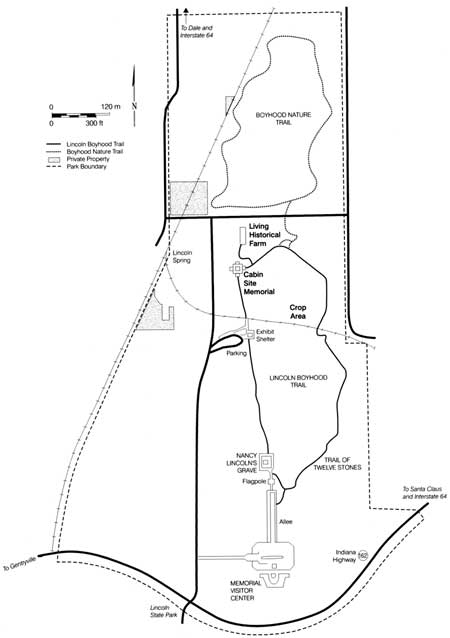|
Lincoln Boyhood
Historic Resource Study |

|
CHAPTER I:
Introduction
In November 2000, HRA Gray & Pape, LLC, (HRAG&P) contracted with the National Park Service (NPS), Midwest Regional Office, to prepare a Historic Resource Study (HRS) of the Lincoln Boyhood National Memorial in Spencer County, Indiana (Contract No. P6300000125). In 1962, Congress designated the Lincoln Boyhood site a National Memorial to preserve the family and boyhood home setting of Abraham Lincoln and the grave site of his mother, Nancy Hanks Lincoln (Figure 1/inside cover). The Lincoln family lived on the Thomas Lincoln farm from 1816 until February 1830, when they moved to Illinois. The memorial site includes a visitor center, park housing complex, memorial and designed historic landscape, walking trails, living history farm, a burial area, and wayside exhibits. Park administrative offices are housed in the visitor center. The site was listed in the National Register of Historic Places (NRHP) in 1973.

|
|
Figure 1: Site Plan of the Lincoln Boyhood National Memorial (click on image for an enlargement in a new window) |
As a management tool, the HRS synthesizes cultural resource information from all cultural resource disciplines in a narrative designed to serve managers, planners, interpreters, cultural resource specialists, and the interested public as a reference for the history of the region and the resources within the park. This HRS is derived from research in primary and secondary records related to environmental history, Native American use and occupation, exploration, land use, settlement patterns, and commemoration of the lives of Abraham Lincoln and Nancy Hanks Lincoln. This study utilizes both documentary research and field observations to determine and describe the integrity, authenticity, associative values, and significance of resources within the memorial site, as well as to highlight areas for future interpretive development. The HRS will serve as the foundation for future cultural resource assessments and management plans. It defines themes of area history; establishes a relationship between events and the built environment; identifies time frames and periods of significance for historic contexts; and identifies links between national, regional, and local events.
This HRS also is designed to address deficiencies in previously completed Lincoln Boyhood National Memorial cultural resource studies. These deficiencies are the result of changing cultural resource management theories and changing management needs arising from increased use of the site and the targeting of a broader audience. Furthermore, in recent years cultural resource managers have placed increased emphasis upon cultural landscapes encompassing the totality of resources that form a system of land use or that now form a multiple-layer depiction of use over time. Natural features (as they influence cultural development), vegetation, land use patterns, and circulation systems are a few of the important elements of cultural landscapes. The Memorial is located in an area rich with Indian, European, early United States military and settlement history, the interwoven effects of which are visible in the present landscape. To interpret and manage the primary cultural resources for which the monument was established, it is critical to understand the evolution of this cultural landscape.
METHODOLOGY
HISTORICAL RESEARCH
HRAG&P undertook a comprehensive literature search for this project in early 2001. This effort resulted in preparation of a chapter outline for the HRS and an annotated bibliography of major primary and secondary sources to be used in the preparation of the document. The research effort began with initial consultation with park and regional NPS office staff and other local informants. It continued with a review of secondary resources and gray literature, followed by primary-source materials at various Indiana repositories. HRAG&P's research focused on four efforts: (1) compilation and mastery of the published literature; (2) familiarity with the primary sources on which the published literature stands; (3) original research in primary sources on issues that pertained specifically to cultural resources within the property; and (4) review of existing cultural resource documentation. Repositories consulted during the course of these investigations included the Lincoln Boyhood National Memorial, the adjacent Lincoln State Park, historical societies in Perry and Spencer Counties, the Indiana State Historic Preservation Office, and the Indiana State Historical Society.
FIELD SURVEY
Information derived from a review of the 1973 National Register nomination for the Lincoln Boyhood National Memorial and from previously completed cultural resource studies, inventories, and surveys of resources guided HRAG&P's field survey, completed in 2001. During the course of fieldwork, the location, integrity, and condition of all previously identified cultural resources were confirmed. The field investigations were informed by the findings of the documentary research, with particular care taken to identify and evaluate cultural landscapes and areas of high archaeological site potential. No subsurface archaeological investigations were conducted as part of this effort. Fieldwork took place in early 2001, with follow-up visits to photograph significant cultural resources taking place in August and November 2001.
PROJECT PERSONNEL
HRAG&P's Senior Historian, Patrick O'Bannon, served as the Principal Investigator for the project. He acted as the primary point of contact with the National Park Service, directed the field survey, undertook preliminary historical research, prepared the management summary and annotated bibliography, and edited the final report. Project Historians Lena Sweeten and Harrison Stamm Gowdy conducted some of the historical research, prepared the historic context, identified areas in need of further research, and developed recommendations for additional interpretive programs. Graphic Artist Casey Fagin created the graphic layout and design of the final report.
| <<< Previous | <<< Contents >>> | Next >>> |
libo/hrs/chap1.htm
Last Updated: 19-Jan-2003